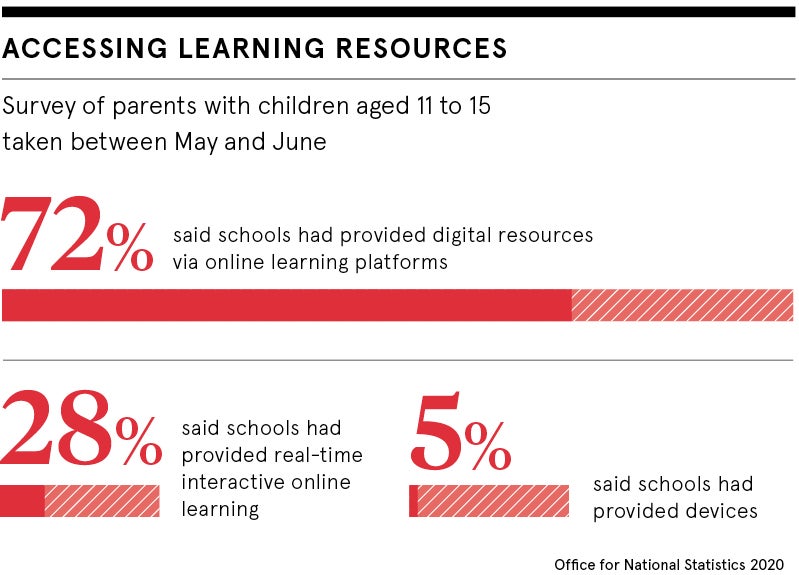Six months ago, millions of people around the world were already using digital learning platforms to master new languages, brush up on health and safety laws or enhance IT skills. More than 300 million people had downloaded language app Duolingo. The already sizeable corporate elearning market was growing at a rate of knots.
But despite this enthusiasm from individuals and corporations, the take-up of education technology (edtech) has often been more piecemeal in schools and colleges. Schools have limited resources and countless priorities. Educators already struggling with heavy workloads lack the time to innovate. Fears persist around security, privacy and the dilution of the primacy of the face-to-face student-teacher relationship.
But that was before the coronavirus pandemic. Almost overnight, educational establishments around the world were forced to adopt digital learning and quickly came to rely on edtech platforms whether they wanted to or not.
“The pandemic hasn’t so much boosted educational technology, as highlighted just how important it is as a toolkit for teachers to learn to use,” says Dr Steve Wheeler, visiting research fellow at Plymouth Institute of Education. “The pandemic has simply highlighted the need for teachers to become more versatile in their pedagogy.”
Accelerating the uptake of online learning
Certainly, there’s a sense that lockdown has accelerated something that was already happening. Wheeler notes that, long before COVID-19, seven million undergraduate students were studying exclusively online in America alone.
Jacqueline Daniell, chief executive of Wey Education, which runs online school InterHigh, believes the pandemic has accelerated global adoption of edtech in schools and colleges by about five years. And, having been forced to embrace digital learning, many educators have come to appreciate it. “The pandemic has proved the benefits and opportunities of virtual learning,” she says. “It has also shown parents and children alternative ways of learning beyond bricks-and-mortar classrooms.”

Wheeler agrees: “What this has highlighted is learning can take place anywhere, anytime and that teaching methods must adapt to meet the new normal.”
But what will the new normal look like? Scores of edtech providers have grasped the COVID opportunity by offering services for free. They filled an urgent need in exceptional circumstances. But as schools and colleges reopen this autumn, might the great global experiment in digital learning start to fizzle out? When COVID restrictions are lifted entirely, will the wide-scale edtech adoption of 2020 seem like a passing fad?
It seems unlikely and not only because the pandemic-accelerated trends already in play. Educational technology encompasses a growing spectrum of tools and methods, many of which were adopted to cover pandemic restrictions, but have since been found to meet existing challenges too.
Research mathematician Dr Junaid Mubeen, director of education at virtual maths tutor solution Whizz Education, agrees edtech has experienced many “false dawns”, but thinks COVID-19 may signal a fundamental shift.
“The pandemic has exposed the inflexibility of our education system,” he says. “Students face countless threats to learning: illness, poverty, the passing of loved ones and, indeed, pandemics; let’s not assume COVID is the last. Flexibility must be ingrained in education systems. Learning must be resilient to the inevitable disruptions faced by students in an increasingly volatile world.”
A future of hybrid learning environments
This has to include a wider use of technology. Rory Nath, an investment manager at private equity firm ECI Partners, specialising in the education sector, says COVID-19 has made it clear that our education system needs a better technology strategy. “A key concern during the pandemic was a widening of the attainment gap for disadvantaged pupils due to a disparity in access to technology,” he says.
So COVID not only exposed the limitations of traditional education systems during a once-in-a-century crisis, it has highlighted systemic inequalities that proponents believe digital learning can help address. In this interpretation, the wider use of technology in education becomes a moral imperative.
At the same time, nobody is under any illusion that the return of face-to-face teaching won’t dampen the edtech surge. But much will remain. Schools and colleges are likely to implement more blended learning regimes, which mix mutually reinforcing off and online learning models and allow teachers to maximise time with students. A simple example is a maths app that automatically marks student work, giving teachers time to plan better lessons along with the data to target them more effectively.
“Blended learning has been a staple for many years in schools and universities around the world, but many more will now follow suit,” says Graham Glass, chief executive of learning platform provider Cypher Learning. “Teachers can personalise lessons through individual learning paths and by measuring competencies accurately. Students are always connected so they can enjoy gamification and learn through conducting research or participating in projects.”
The vast potential of digital learning
In fact, edtech solutions are now so wide-ranging that it becomes hard to imagine post-pandemic learning environments without them. As well as direct learning apps, edtech can facilitate the easy sharing of resources. It can set and mark revision quizzes. It can help with homework. Nath at ECI Partners points out investors are particularly excited about solutions that remove some of the administrative burden from teachers, such as safeguarding children, which frees up more time for teaching.
Edtech has long been seen as something of the poor relation of healthtech and fintech, hamstrung by inadequate funding and the need to adhere to national curriculums. COVID-19 may be about to change all that. “When the dust settles, digital education will have advanced years in months,” says Dr David Lefevre, director of the Edtech Lab at Imperial College Business School. “Working practice has already changed and many temporary solutions will become permanent. A growth in digital education is inevitable.”
Accelerating the uptake of online learning

